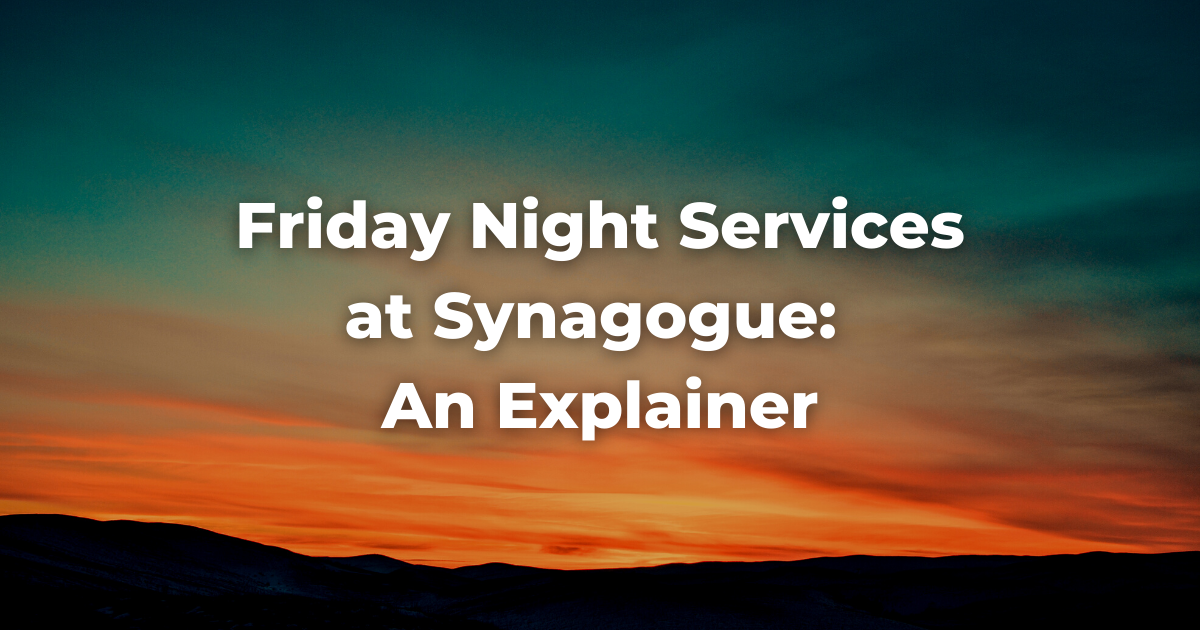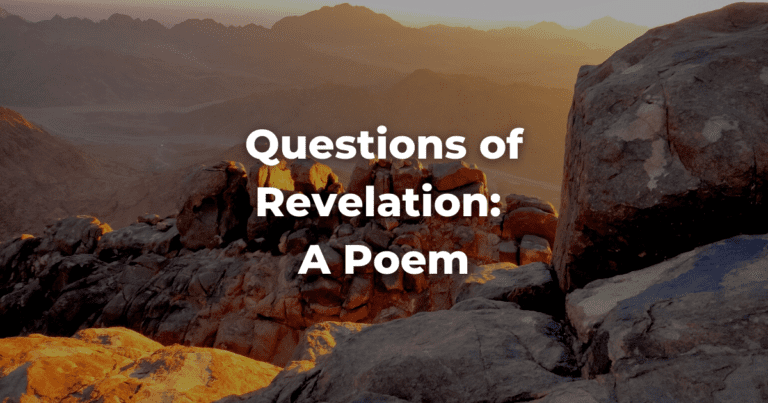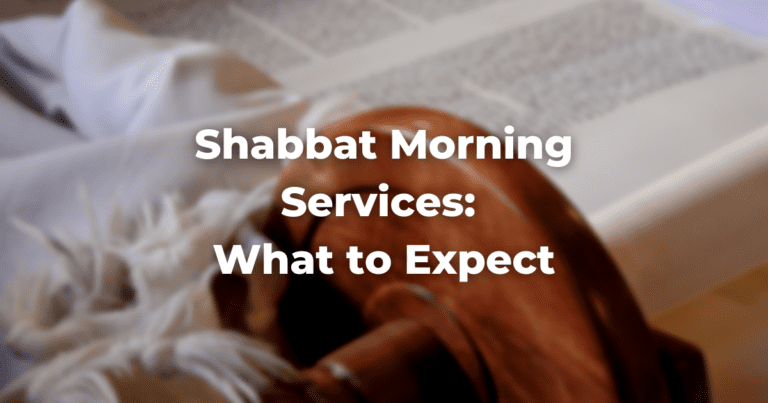The History
Traditionally, Shabbat services on Friday night were held around sunset, whatever time that happened to be. Dinner then followed, and the family remained at home for the rest of the evening.
By the middle of the twentieth century, however, it became apparent that many people were unable to make it home on Fridays in time for a traditional Shabbat service at sundown, especially during the fall and winter months when Shabbat can sometimes begin very early. In response, synagogues began offering late Friday evening services that usually began at 8:00 or 8:30 P.M. year-round.
This enabled people to attend a Friday night Shabbat service at synagogue (though it also meant that the Friday night meal at home had to end in time to enable the family to get there).
For decades, late Friday night worship was the more attended Shabbat service in many Conservative synagogues. In recent years, another trend has developed as large numbers of congregations have gone back to the practice of having Friday evening services at sundown.
This return to tradition may stem from several factors, foremost among them the influence of Camp Ramah, the realization that the home (not the synagogue) should be the primary focus of Jewish observance, the disappearance of Friday night bat mitzvah ceremonies in Conservative synagogues, and the preference of many clergy and laity for more authentic modes of Shabbat observance.
Most of all, however, the shift back to a more traditional framework has been prompted by the sense that there is something inimical to the spirit of Shabbat about having to go out again after a traditional Friday night dinner at home in the company of one’s family and one’s guests.
Reciting Song of Songs and Y’did Nefesh
In preparation for the formal worship service on Friday evenings, some have the custom of reading the Song of Songs, and this worthy custom should be encouraged.
Though ostensibly a series of secular love poems, the rabbis of classical antiquity understood the Song of Songs to be an allegory about God’s love for the Jewish people. The poet refers to his beloved as his bride, the very term used to describe Shabbat.
Reciting the Song of Songs, or parts of it, helps us to view Shabbat as a day devoted to the celebration of God’s love for Israel, as well as Israel’s love for God and for Shabbat itself. It is also appropriate as a subtle reminder to married couples that Friday night is the traditional time for marital intimacy.
Another custom is to sing the hymn Y’did Nefesh (also written Yedid Nefesh), composed in sixteenth-century Safed by Rabbi Eleazar Azikri, whose theme is also the Jew’s longing for communion with the Divine.
Where did Kabbalat Shabbat Come From?
Formally speaking, there are two major parts to the Friday evening service: Kabbalat Shabbat and Maariv.
Kabbalat Shabbat (literally, “Welcoming Shabbat”) was created by the mystics of Safed among whom Rabbi Azikri lived, who believed that Shabbat functions as a foretaste of the ultimate redemption even more than it serves as a day of rest from labor.
The concept of Kabbalat Shabbat itself was based on a Talmudic teaching (preserved on Shabbat 119a:2):
“Rabbi Hanina would wrap himself in a robe on the eve of Shabbat and say: ‘Come, let us go out to greet Queen Shabbat.’ Rabbi Yannai would get dressed on the eve of Shabbat and say: ‘Come, O bride! Come, O bride!’”
Why did Rabbi Hanina and Rabbi Yannai conceive of Shabbat as a female figure, a bride or a queen? Perhaps they saw the other days of the week, devoted all to hard work, as corresponding to the role of men in their world, while Shabbat was about the home, the family, and peace, which they considered the domain of the feminine.
Their specific approaches are not exactly the same, however.
Rabbi Hanina, imagining someone regal and powerful who commands respect and obedience, speaks of a queen. On the other hand, Rabbi Yannai, conjuring up the image of a beautiful and tender woman who primarily symbolizes love, talks of a bride.
The two combine to draw a picture of Shabbat as a set of complex laws that must be obeyed, yet that somehow also create the context in which Jewish individuals can come to know and love God with ever greater levels of intimacy.
The Kabbalat Shabbat Service
Kabbalat Shabbat begins with the recitation of Psalms 95, 96, 97, 98, 99, and 29, which are considered representative of the six days of the week. All six psalms refer to God as melekh (king), and speak of God as Creator and Ruler of the world.
Thus, in the context of the Kabbalat Shabbat liturgy, the Jew at prayer is attending the mystic wedding of King God and Queen Shabbat.
L’khah Dodi
The six psalms lead into L’khah Dodi (also written Lecha Dodi), a long liturgical poem written in 1529 by Rabbi Shlomo Halevi Alkabetz (whose name is spelled out by the initial letters of the first eight stanzas). The chorus, based on the Talmudic passage cited just above, is “Come, my beloved, to greet the bride / let us welcome Shabbat.”
Several of the verses refer to the city of Jerusalem, to its desolation and destruction in past times, and to its renewal in the context of the future redemption of humanity. Jerusalem, in this context, is understood as a symbol of the Jewish people. As Jerusalem will be revived, the poet says, so will the Jews. In L’khah Dodi, therefore, people, place, and time all come together in the complex concept of salvation through God.
During the final stanza of L’khah Dodi, the congregation rises and turns around symbolically to greet Shabbat. As the final line of the hymn is sung, the congregation bows twice, once to the left and once to the right.
This act of subservience can be interpreted both according to the opinion of Rabbi Hanina and that of Rabbi Yannai. By bowing to Queen Shabbat, the congregation at once pledges its allegiance and demonstrates its subservience to its laws and precepts. If, however, it is to Bride Shabbat that the congregation bows, then it is to show its devotion and love for Shabbat in its guise as the welcome harbinger of redemption.
It is also at this moment in the service, at the conclusion of L’khah Dodi, that mourners still in their first week of mourning (the shivah week) enter the synagogue. The congregation, which has just risen to welcome Queen Shabbat and Bride Shabbat, remains standing to greet the mourners with the traditional words of consolation:
Ha-makom y’na ̇eim etkhem b’tokh she·ar aveilei tziyyon virushalayim
May God comfort you together with the other mourners of Zion and Jerusalem.הַמָּקוֹם יְנַחֵם אֶתְכֶם בְּתוֹךְ שְׁאָר אֲבֵלֵי צִיּוֹן וִירוּשָׁלַיִם
By singing L’khah Dodi, the congregation has just proclaimed that the destruction of Jerusalem will be followed ultimately by its redemption. As the mourners enter, the worshipers pray that, though the mourners have recently experienced personal devastation, they too will find comfort and redemption. For Jews, the national and the personal always are intertwined.
Kabbalat Shabbat Service Continued
L’khah Dodi is followed by Psalms 92 and 93. Psalm 92, the only poem in the Psalter connected to a specific day of the week, was imagined by the ancients to have been uttered originally by Adam as an ode of thanksgiving on the very first Shabbat. Also, the MishnahA collection of rabbinic teachings edited in Israel around 225 CE. Organized in six sedaraim by subject matter and dealing with both ritual and civil law. Both the Jerusalem and Babylonian Talmud are expansive discussions of the Mishnah. Read more (at M Tamid 7:4) teaches that the Levites used to sing this psalm every Shabbat in the Temple and that it will be the hymn of choice in the messianic era as well.
Psalm 93 also hints at the messianic theme, looking forward to a time when God, “crowned in splendor,” will rule directly over the world. Kabbalat Shabbat concludes with the Mourner’s Kaddish.
In Between Kabbalat Shabbat and Maariv
It is the custom of some to recite the second chapter of the Mishnaic tractate Shabbat between Kabbalat Shabbat and the Evening Service (SA Orach Chayyim 270:2). These seven mishnayyot are an example of the use of the study of traditional texts as a kind of intense spiritual preparation.
The practice also had a very practical aspect: it delayed the beginning of the Evening Service so that latecomers would not be forced to make their way home alone in the dark after finishing their prayers after the departure of the other worshipers.
The liturgy of contemporary Conservative Judaism preserves this tradition, while changing some of the texts. The traditional chapter from tractate Shabbat (often called Ba-meh Madlikin, after its first words) focuses on the technical question of which materials may be used for lighting oil lamps on Shabbat, an issue rendered irrelevant by the almost universal use of wax candles in modern times.
Conservative prayerbooks, therefore, often offer other mishnayyot and rabbinic texts thought to be both instructive and inspirational. Any of these texts should be followed by Kaddish D’rabbanan.
The Maariv Shabbat Service
The Maariv service for Friday night is similar to the weekday service, but with a few changes.
The opening line that precedes the Bar’khu call to prayer, for example, is eliminated because its subjects (sin and punishment) are not considered to be in the spirit of Shabbat. Also, an additional line and a slightly expanded benediction are added to the end of the Hashkiveinu prayer, the second blessing that follows the Sh’ma.
In this version of the blessing, the worshiper speaks of God spreading a sukkah of peace over all Israel and over Jerusalem. As in the L’khah Dodi hymn, people, place, and time all come together in a dream-like vision of future redemption.
A special passage referring specifically to Shabbat, Exodus 31:16–17 (often called V’sham’ru after its first word), is added just after Hashkiveinu. In the Hashkiveinu prayer, the worshiper asks God to guard and watch over Israel, and this passage from Exodus uses similar language to describe Israel’s observance of Shabbat—suggesting that, just as the Jewish people guard and watch over Shabbat, so does God care for and watch over the Jewish people.
The Maariv Shabbat Amidah
There are also some major omissions from the weekday service, such as the long miscellany of verses recited on weekdays just before the Kaddish that leads into the Amidah. Also, the entire middle portion of the Amidah, which consists on weekdays of thirteen different petitionary prayers, is replaced by a single paragraph referring to Shabbat itself. (The petitions in the middle section of the weekday Amidah are eliminated because it is considered inappropriate to express concern for material needs on Shabbat.)
The Amidah on Friday evening, therefore, has only seven blessings, as do the morning and afternoon versions of the Amidah on Shabbat. The specific theme of this central section changes for each of the three services of the day, however.
On Friday night, the central passage cites Genesis 2:1–3 and is primarily about Shabbat today as a memorial to the first Shabbat, the one that followed the week of creation.
On Saturday morning, the central prayer speaks more about revelation, and depicts Shabbat as a central pillar of the commandments revealed to Israel at Mount Sinai. On Saturday afternoon, the central paragraph focuses on redemption and points to Shabbat as kind of weekly herald of the kind of peaceful world that all will enjoy when the world finally is redeemed. Creation, revelation, and redemption are the three great themes of Jewish theology and each has its moment in the liturgy of Shabbat.
The Conclusion of Maariv
Following the Amidah, the congregation remains standing to recite Genesis 2:1–3, popularly called Va-y’khullu. This is followed by a special, highly abbreviated version of the Amidah called the “Blessing Reminiscent of the Seven [Blessings of the Amidah],” the b’rakhah mei-ein sheva. This in turn is followed by the Magein Avot prayer, and then by the prayer leader’s repetition of a key passage from the Amidah.
All these additions were intended simply to delay the service sufficiently for latecomers to catch up so that they would not be forced to walk home alone.
There is also a very old custom of reciting Kiddush, the prayer of sanctification over the wine normally recited at dinner, in the synagogue as well (SA Orach Chayyim 269). This custom goes back to a time when Jewish travelers lodged in the synagogue and had their meals there, and it thus created an opportunity for the regular worshipers to join with the community’s guests before parting company.
Today, it is rare for worshipers to dine in the synagogue after the service, but the custom remains as a pleasant reminder of ancient times when a community’s hospitality could be measured easily in terms of how it treated strangers, travelers, and the indigent on Shabbat by providing for their needs in a gracious and friendly way.
The service then concludes with Aleinu and the Mourner’s Kaddish, followed in most congregations by the Yigdal hymn.
Adapted with permission from The Observant Life.
Authors
-

Born and raised in Philadelphia, Rabbi Katz received his B.A. from Temple University, and a Bachelors of Hebrew Literature from Gratz College. He was awarded a Masters Degree from the Jewish Theological Seminary, where he received his Rabbinic ordination. In 2005, JTS awarded the rabbi the degree of Doctor of Divinity.
Rabbi Katz has been strongly involved in the institutions of Conservative Judaism. He was a regional president of United Synagogue Youth; a staff member for twenty years at Camp Ramah; past president of the Rabbinical Assembly of Nassau-Suffolk; a founder of the Solomon Schechter High School; and a class Rabbi at the Schechter Day School of Nassau County, in Jericho. He also serves on the Conservative Bet Din, the Rabbinic Court supervising conversions on Long Island.
View all posts -

The Observant Life: The Wisdom of Conservative Judaism for Contemporary Jews distills a century of thoughtful inquiry into the most profound of all Jewish questions: how to suffuse life with timeless values, how to remain loyal to the covenant that binds the Jewish people and the God of Israel, and how to embrace the law while retaining an abiding sense of fidelity to one’s own moral path in life.
Written in a multiplicity of voices inspired by a common vision, the authors of The Observant Life explain what it means in the ultimate sense to live a Jewish life, and to live it honestly, morally, and purposefully. The work is a comprehensive guide to life in the 21st Century. Chapters on Jewish rituals including prayer, holiday, life cycle events and Jewish ethics such as citizenship, slander, taxes, wills, the courts, the work place and so much more.
View all posts




